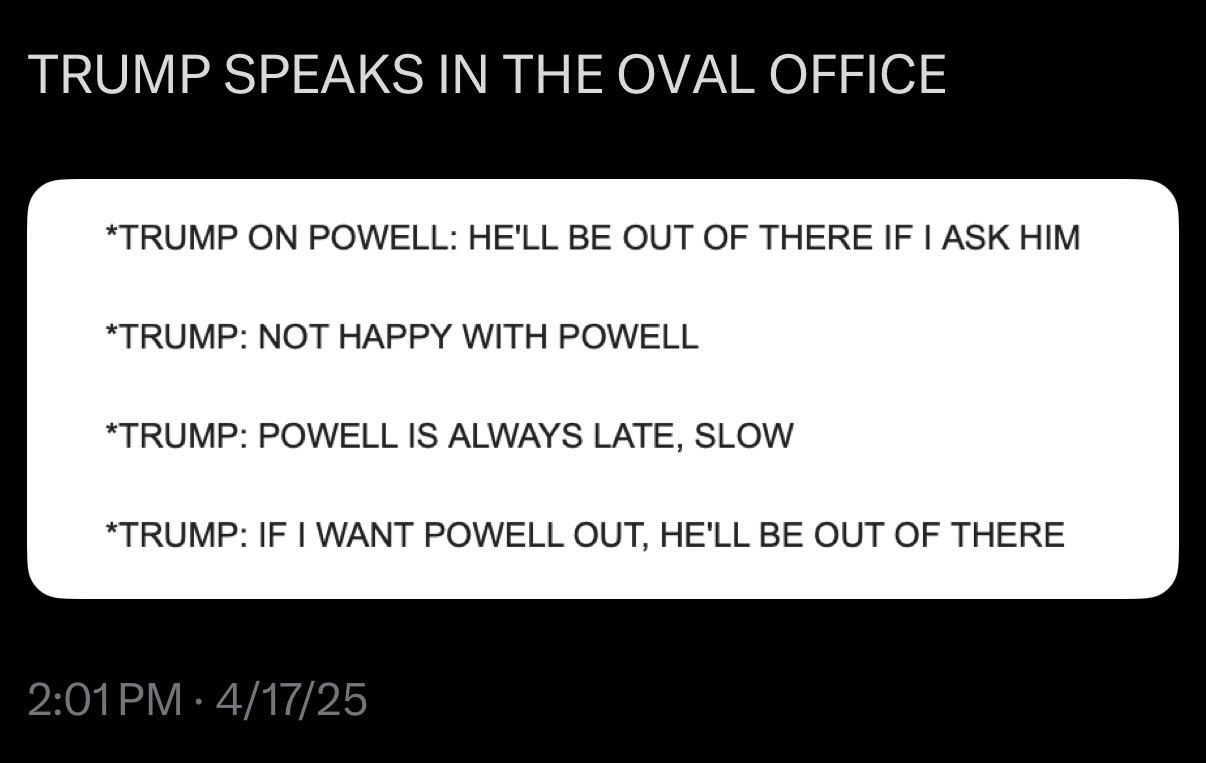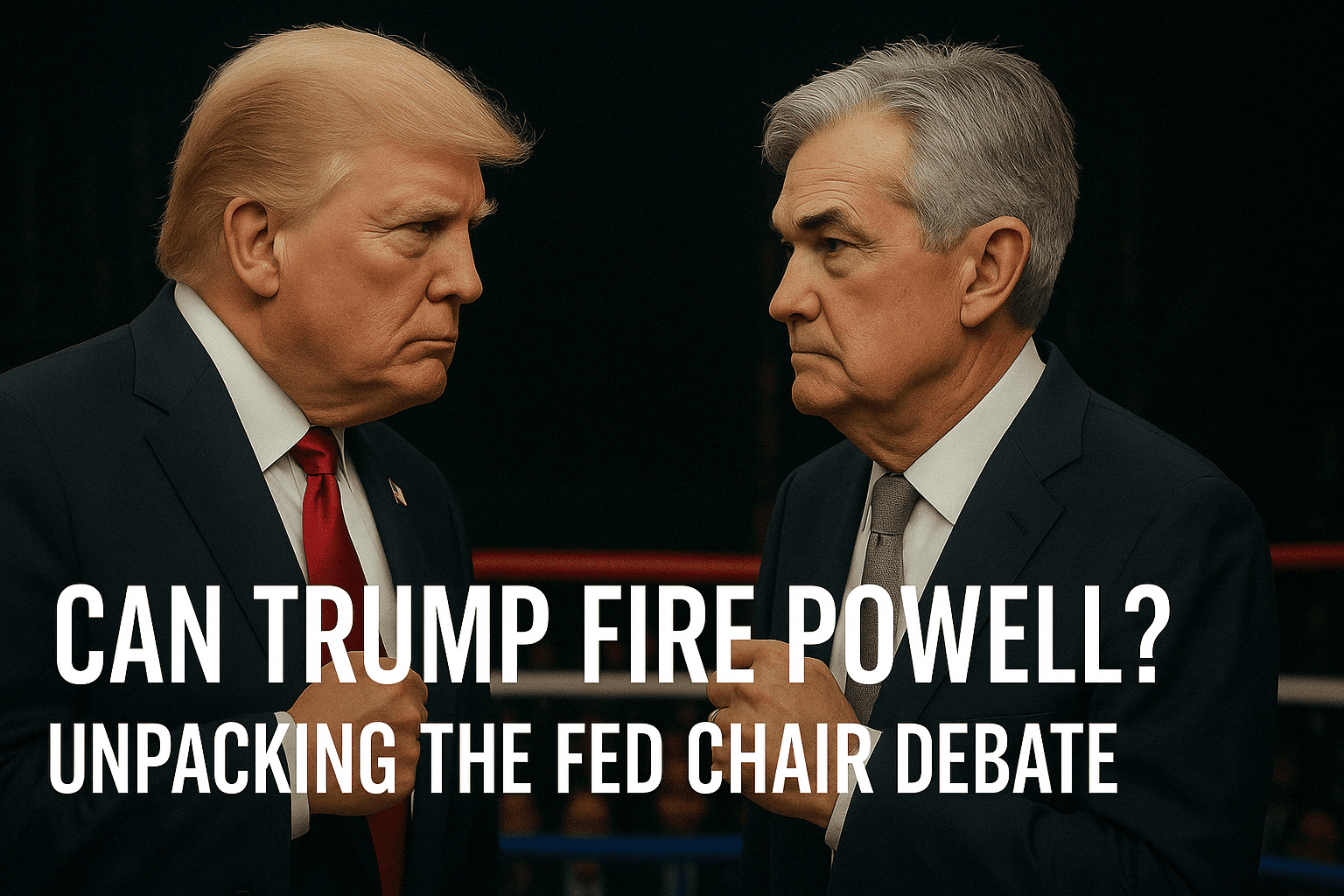Summary
President Trump wants Fed Chair Jerome Powell out—can a sitting president fire the head of the Federal Reserve?
Market Recap
Market Movers
- 📈 Flash Manufacturing PMI : Apr 23, 2025
- 📈 Unemployment Claims: Apr 24, 2025
📚 Deep Dive 📚
Trump vs. Powell – A Power Struggle Heating Up
On Thursday April 17, 2025, President Donald Trump reignited a fiery debate by suggesting that Jerome Powell, the current Federal Reserve Chair, could and maybe even should be fired—frustrated that Powell hasn’t cut interest rates amid rising economic pressures. Trump argues that Powell is refusing to act because of political motives, not economic ones. But can a president actually fire the head of the Federal Reserve?
In this article, we’ll break down how the Fed Chair is appointed, what the Constitution says about removing them, and whether Trump’s threat is just tough talk—or a real possibility.
The Basics: How the Fed Chair Is Appointed
- The Federal Reserve Chair is nominated by the President and confirmed by the Senate.
- The term lasts four years, but the Chair can be reappointed.
- While the Chair leads the Federal Reserve Board, they are also a member of the Board of Governors, who serve 14-year staggered terms and can only be removed “for cause.”
📜 Constitutional & Legal Framework
- The Federal Reserve Act doesn’t give the President direct power to fire the Chair without cause.
- Legally, the Chair is considered a quasi-independent officer, meant to shield monetary policy from political interference.
- Article II of the Constitution gives the President power to appoint (and potentially remove) officers of the United States, but this is subject to congressional limits, especially for independent agencies.
📚 Precedent & Power Limits
The Supreme Court ruling in Humphrey’s Executor v. United States (1935) held that the President cannot remove heads of independent agencies (like the FTC) at will—only "for cause."
The Fed is similar in design. Removing Powell without "cause" could prompt a legal and political firestorm. But that is not to say President Trump does not have "cause"....
⚖️ What Counts as “Cause”?
“Cause” is typically interpreted to mean malfeasance, neglect of duty, or inability to perform the job.
Disagreeing over interest rates or refusing to cut rates would not qualify as legal grounds for dismissal.
💬 Trump’s Position
Trump has openly criticized Powell since appointing him in 2018, calling rate hikes “crazy” and accusing Powell of being politically motivated.
Flashback to 2018: after appointing Jerome Powell as Fed Chair, Trump quickly turned on him when the Fed began raising interest rates. Trump broke presidential norms by publicly attacking the Fed, calling Powell’s rate hikes “crazy” and a threat to economic growth. Behind closed doors, Trump reportedly explored whether he could demote or fire Powell—a rare and controversial move. The pressure campaign intensified in 2019, when Trump openly urged the Fed to slash rates and resume quantitative easing, going as far as comparing Powell to “a golfer who can’t putt.”
Under immense political and market pressure, the Fed shifted course and began cutting rates in mid-2019. While the Fed maintained it was responding to slowing global growth and trade tensions, many saw it as a sign that Trump’s loud and relentless push had, at least partially, influenced monetary policy—raising deep concerns about the Fed’s independence.
Today he is heading down the same path with Fed Chair Powell. Here are some of his comments from Thursday:

💡 Political Implications
Even if Trump tried to remove Powell, it would almost certainly end up in the courts.
Such a move could rattle markets (as if it has not been already), raise concerns about the Fed’s independence, and set a historic precedent (a new normal?).
Final Thoughts: Why This Matters It’s becoming clear that the Fed, under Powell, is well aware that Trump’s tariff war could hit the economy hard. Yet their passive stance—sitting in "idle mode" while risks build—does little to inspire confidence. At the very least, the Fed should be loud and clear in reassuring markets that they’re ready to cut rates swiftly if needed and will take action to stabilize growth. Instead, their silence feels strategic, almost as if they’re unwilling to support Trump’s economic agenda during this critical moment. And if that’s the case—if Powell is going to play politics—then maybe it’s time he steps aside. Monetary policy shouldn’t be a battleground for political games.
So can Trump fire Powell? Not easily. Not without a fight. And not without triggering a constitutional crisis that would shake Wall Street and Washington alike - but isn't that the new normal?


